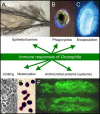Innate immunity in fruit flies: a textbook example of genomic recycling
- PMID: 15314671
- PMCID: PMC509316
- DOI: 10.1371/journal.pbio.0020276
Innate immunity in fruit flies: a textbook example of genomic recycling
Abstract
Drosophila serve as a wonderful model for studying aspects of innate immunity, i.e. the physical, cellular, and molecular features that provide the first lines of defense against infections in flies and man
Figures


References
-
- Brennan CA, Anderson KV. Drosophila: The genetics of innate immune recognition and response. Annu Rev Immunol. 2004;22:457–483. - PubMed
-
- Beutler B, Rehli M. Evolution of the TIR, tolls and TLRs: Functional inferences from computational biology. Curr Top Microbiol Immunol. 2002;270:1–21. - PubMed
-
- Christophides GK, Zdobnov E, Barillas-Mury C, Birney E, Blandin S, et al. Immunityrelated genes and gene families in Anopheles gambiae . Science. 2002;298:159–165. - PubMed
Publication types
MeSH terms
Substances
LinkOut - more resources
Full Text Sources
Molecular Biology Databases

